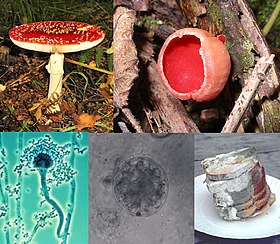Èbu
Ìrísí
(Àtúnjúwe láti Fungus)
| Fungi | |
|---|---|

| |
| Clockwise from top left: Amanita muscaria, a basidiomycete; Sarcoscypha coccinea, an ascomycete; bread covered in mold; a chytrid; a Penicillium conidiophore. | |
| Ìṣètò onísáyẹ́nsì | |
| Àjákálẹ̀: | |
| (unranked): | |
| Ìjọba: | Fungi |
| Subkingdoms/Phyla/Subphyla[2] | |
|
Dikarya (inc. Deuteromycota) Subphyla Incertae sedis | |
Èbu

|
Àyọkà yìí tàbí apá rẹ̀ únfẹ́ àtúnṣe sí. Ẹ le fẹ̀ jù báyìí lọ tàbí kí ẹ ṣàtúnṣe rẹ̀ lọ́nà tí yíò mu kúnrẹ́rẹ́. Ẹ ran Wikipedia lọ́wọ́ láti fẹ̀ẹ́ jù báyìí lọ. |
